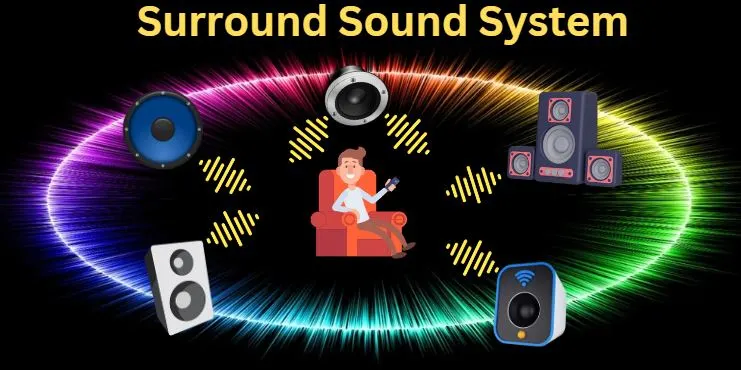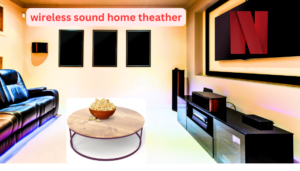Surround Sound Systems create quite an immersive experience in the world of audio and entertainment. Whether you’re a movie enthusiast, a gamer, or simply someone who appreciates high-quality audio, understanding the different types of surround sound systems and choosing the best one for your needs is crucial. In this comprehensive guide, we’ll delve into the definition and types of surround sound systems, compare various options. If you want to select the best multi-channel home theater with surround sound technology for your home or entertainment space, I recommend you visit my Multi-Channel Home Theatre Buying Guide.

Table of Contents
Defining Surround Sound Systems
Surround sound systems are audio setups designed to envelop the listener in a three-dimensional soundscape, providing a more immersive and realistic audio experience. They are widely used in home theaters, gaming setups, and even some high-end music systems. The core principle behind surround sound is to recreate the spatial dimension of sound, making you feel like you’re right in the middle of the action.
Types of Surround Sound Systems
There are several types of surround sound systems, each offering a unique audio experience. Let’s explore the most common ones:
1.5.1 Surround Sound

The 5.1 surround sound system is one of the most popular setups for home theaters. It consists of five speakers and one subwoofer. The “5” represents the five main speakers, which are typically positioned in the front (left, center, and right) and rear (left and right) of the room. The “1” stands for the subwoofer, responsible for delivering deep, powerful bass.
2. 7.1 Surround Sound

Building upon the 5.1 setup, the 7.1 surround sound system adds two more speakers to the mix. These additional speakers enhance the surround sound experience by providing even more precise audio positioning. The extra speakers are usually placed behind or to the side of the listener.
3. 9.1 Surround Sound and Beyond
For true audiophiles and those with substantial home theater spaces, configurations like 9.1, 11.1, or even 22.2 (yes, twenty-two speakers!) are available. These systems provide unparalleled audio immersion, but they require careful placement and significant investment.
4. Dolby Atmos
Dolby Atmos is a cutting-edge audio technology that takes surround sound to the next level. It uses speakers placed not only around the listener but also overhead. This setup creates a truly three-dimensional soundstage, allowing sound to move freely in any direction. Dolby Atmos is particularly popular in high-end home theaters and cinemas.
5. Soundbars with Virtual Surround Sound
For those with limited space or a tighter budget, soundbars with virtual surround sound technology are a great option. These compact devices use advanced audio processing to simulate the effect of multiple speakers, creating a wider soundstage. While not as immersive as traditional setups, they offer a significant improvement over built-in TV speakers.
6. Wireless Surround Sound Systems
Wireless surround sound systems eliminate the need for cumbersome cables and wiring. They typically consist of wireless speakers that can be placed around the room without the hassle of running cables. While convenient, some audiophiles may argue that they don’t offer the same audio quality as wired systems.
Working Of Surround Sound Systems
The workings of a surround sound system involve multiple speakers strategically placed to create an immersive audio experience. It aims to reproduce the way sound is heard in the real world, providing depth, directionality, and dimensionality to the audio. Here’s how a typical surround sound system operates:
- Audio Sources: Surround sound systems receive audio signals from various sources, such as a Blu-ray player, DVD player, gaming console, TV, or streaming devices. These sources send both audio and video signals to the surround sound receiver or amplifier.
- Surround Sound Receiver/Amplifier: The heart of the system is the surround sound receiver or amplifier. It receives audio signals from the sources, processes them, and distributes them to the appropriate speakers. Modern receivers are equipped with advanced audio processing technologies like Dolby Digital, DTS, and more, which decode and enhance the audio for a more immersive experience.
- Speaker Configuration: Surround sound systems consist of multiple speakers, each with a specific role:
- Center Channel Speaker: Typically placed above or below the TV screen, the center channel speaker is responsible for reproducing dialogue and central audio information. It ensures clear and precise speech in movies and TV shows.
- Front Left and Right Speakers: These speakers are usually placed on either side of the TV or projection screen. They handle most of the audio coming from the front, providing a stereo effect for music and delivering directional sound effects in movies and games.
- Rear or Surround Speakers: These speakers are placed behind or on the sides of the listening area, creating ambient and directional sound effects that make the viewer feel surrounded by audio. In a 5.1 system, there are two rear speakers, while 7.1 systems have four.
- Subwoofer: The subwoofer specializes in reproducing low-frequency sounds, often referred to as bass. It adds depth and impact to explosions, music, and other low-frequency effects, enhancing the overall audio experience.
- Audio Processing: The surround sound receiver processes the audio signals and uses the information encoded in formats like Dolby Atmos, DTS:X, or other surround sound formats to determine which speakers should reproduce specific sounds. It calculates the timing, volume, and directionality of each sound and sends the corresponding signals to the appropriate speakers.
- Speaker Placement and Calibration: Proper speaker placement is crucial for an effective surround sound experience. The surround sound system may come with a calibration microphone that you place in your listening area. The receiver emits test tones, which the microphone picks up to determine the optimal settings for speaker levels, distances, and delays. This calibration ensures that audio is synchronized and balanced across all speakers.
- Playback: Once the system is set up and calibrated, it’s ready to play audio. As you watch a movie, play a game, or listen to music, the surround sound system will reproduce sounds from the various speakers to create an immersive and realistic audio environment. For example, if there’s a car passing from left to right on the screen, you’ll hear the sound moving from the left front speaker to the right front speaker, and eventually to the rear speakers, creating a sense of movement and depth.
Comparison Of Different Surround Sound Systems
Now that we’ve covered the main types of surround sound systems, let’s compare them based on various factors:
Audio Quality
- 5.1 and 7.1 Systems: These systems offer excellent audio quality with clear dialogue and powerful bass, making them suitable for most home theaters.
- Dolby Atmos: This provides the highest audio quality and the most immersive experience, but it can be expensive to set up.
- Soundbars with Virtual Surround Sound: Good audio improvement over TV speakers, but may not match the quality of traditional setups.
- Wireless Systems: Audio quality can vary widely depending on the brand and model. Some high-end wireless systems can rival wired setups.
Setup Complexity
- 5.1 and 7.1 systems Require careful positioning of multiple speakers and cable management.
- Dolby Atmos: Complex setup due to the addition of overhead speakers, often requiring professional installation.
- Soundbars with Virtual Surround sound: Extremely easy to set up, often a “plug and play” solution.
- Wireless systems: Easiest setup, as they eliminate the need for running cables.
Cost
- 5.1 and 7.1 Systems: Moderate cost, with price variations based on brand and features.
- Dolby Atmos: High cost, especially when factoring in overhead speakers and compatible AV receivers.
- Soundbars with Virtual Surround Sound: Affordable to moderately priced, making them accessible for many consumers.
- Wireless Systems: Their cost varies widely, but they can be budget-friendly options.
Recommendation: The Best Surround Sound System
Selecting the best surround sound system depends on your specific needs and budget. After thorough consideration and market research, the 5.1 Surround Sound System remains a top recommendation for most home entertainment setups. It strikes a balance between affordability and performance, making it accessible to a broad audience.
One standout option in the 5.1 category is the Sonos Arc. This system combines sleek design with exceptional sound quality, including a dedicated center channel for dialogue clarity and a powerful subwoofer for deep bass. Additionally, it integrates seamlessly with popular streaming services and voice assistants, enhancing its versatility.
For a premium, cinema-like experience, Dolby Atmos is the top choice. However, it comes with a higher price tag and more setup complexity. If you’re looking for a good balance between audio quality and affordability, a 5.1 or 7.1 system is a solid option. Soundbars with virtual surround sound are ideal for those with limited space or a tighter budget, offering a significant audio upgrade over built-in TV speakers. Wireless systems provide convenience but may not match the audio quality of wired setups.
Ultimately, the “best” surround sound system is the one that suits your preferences and fits seamlessly into your entertainment space. Consider your room size, budget, and desired audio quality when making your decision, and you’ll be on your way to enjoying a more immersive audio experience that enhances your movies, games, and music like never before.
Conclusion
In conclusion, surround sound systems are the cornerstone of a captivating audio experience in your home. Understanding the different types, considering your room size, budget, and compatibility, and choosing the right system can transform your movie nights, gaming sessions, and music listening into immersive adventures. So, why wait? Elevate your audio experience today with the perfect surround sound system for your needs.




I apologise, but, in my opinion, you commit an error. I suggest it to discuss.
Yes kindly share
In it something is. Thanks for the help in this question, can I too I can to you than that to help?